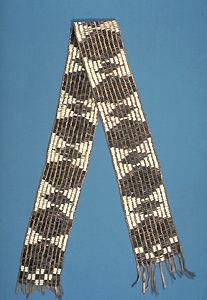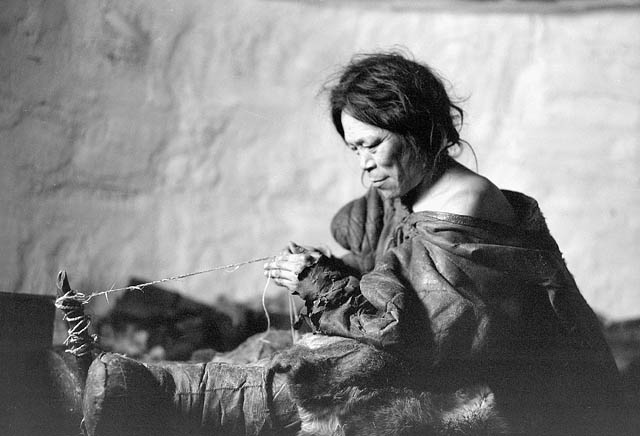Wampum are tubular purple and white beads made from shells. Wampum are used primarily by Indigenous peoples of the Eastern Woodlands for ornamental, ceremonial, diplomatic and commercial purposes. Belts made of wampum were used to mark agreements between peoples. (See also Covenant Chain and Treaties with Indigenous Peoples in Canada.)
What is Wampum?
Wampum — which comes from a Narragansett (Algonquian language family) word meaning a string of white shell beads — are tubular beads manufactured from Atlantic coast seashells. While a variety of shells may be used, most often the white shells are formed from the whelk shell and the purple from the quahog clam shell.
Belts made of wampum were used to mark agreements between peoples. Wampum belts are of particular significance with regards to treaties and covenants made between Indigenous peoples and European colonial powers.
Function and Uses of Wampum
Indigenous peoples living along the coast collected the shells, produced the beads, and traded them in-land, for example to the Haudenosaunee, for furs, corns, beans and squash.
The beads had considerable value in eastern and maritime Canada for ornament, ceremony, the fur trade and diplomacy, particularly in the 17th and 18th centuries.
Wampum was threaded on string or woven into bracelets, necklaces, collars, sashes and later into belts that served as physical representations of political agreements. Particular patterns symbolized events, alliances or kinship relations between different peoples, and wampum could be used to confirm relationships, propose marriage, atone for murder or ransom captives. Beads and belts also validated treaties and were used to recall oral tradition. Many communities had wampum keepers, who protected the belts and interpreted the history contained therein.
Wampum Belts, Treaties and Alliances
Before Confederation some groups of Indigenous people, particularly those in the Eastern Woodlands, indicated their agreement to certain treaties by presenting long wampum belts to Crown officials. Some examples include the Hiawatha Belt (the belt of the Haudenosaunee), the Covenant Chain Wampum of 1764, and the Two Row Wampum Belt (Kaswentha).
Two Row Wampum Belt (Kaswentha)
The Two Row Wampum Belt (Kaswentha) of the Haudenosaunee is a well-known example of a wampum belt. It still symbolizes an agreement of mutual respect and peace between the Haudenosaunee and European newcomers (initially the Dutch) to North America. The principles were embodied in the belt by virtue of its design: two rows of purple wampum beads on a background of white beads represent a canoe and a European ship. The parallel paths represent the rules governing the behaviour of the Indigenous and European peoples. The Kaswentha stipulates that neither group will force their laws, traditions, customs or language on each other, but will coexist peacefully as each group follows their own path.
The Kaswentha continues to represent the Covenant Chain alliance between the Six Nations and their European partners, extending from the 17th century to modern times. As a foundational philosophical principle of respect and friendship, the Belt may be able to function as a framework for improved relations between Indigenous peoples and various levels of government.
Contemporary Significance
Wampum belts and other wampum bead artifacts continue to hold significance for Indigenous peoples and any treaties or agreements they might represent.
Numerous wampum artifacts exist in private collections and in local, provincial and national museums both in Canada and the United States. Wampum in public collections have become the subject of repatriation negotiations between community members and institutional officials who seek to uphold the rights of a given community to their cultural artifacts while balancing traditional care and preservation techniques.

 Share on Facebook
Share on Facebook Share on X
Share on X Share by Email
Share by Email Share on Google Classroom
Share on Google Classroom













